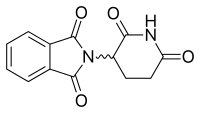Immunomodulatory imide drug
| Immunomodulatory imide drug | |
|---|---|
| Drug class | |
 Thalidomide | |
| Class identifiers | |
| Use | Erythema nodosum leprosum, multiple myeloma, myelodysplastic syndrome, acute myeloid leukaemia and other immunologic conditions |
| ATC code | L04AX |
| Biological target | TNF, IL-6, VEGF, NF-kB, etc. |
| Clinical data | |
| Drugs.com | Drug Classes |
| In Wikidata | |
Immunomodulatory imide drugs (IMiDs) are a class of immunomodulatory drugs[1] (drugs that adjust immune responses) containing an imide group. The IMiD class includes thalidomide and its analogues (lenalidomide, pomalidomide, and apremilast).[1]
The name "IMiD" alludes to both "IMD" for "immunomodulatory drug" and the forms imide, imido-, imid-, and imid.
Generations
There are three generations of IMiDs, with each successive generation being better tolerated and more active against inflammatory and malignant conditions.[1]
- First generation — thalidomide
- Second generation — lenalidomide and pomalidomide
- Third generation — apremilast
Medical use
The primary use of IMiDs in medicine is in the treatment of cancers and autoimmune diseases (including one that is a response to the infection leprosy).[2] Indications for these agents that have received regulatory approval include:[3]
- Myelodysplastic syndrome, a precursor condition to acute myeloid leukaemia
- Erythema nodosum, a complication of leprosy
- Multiple myeloma
Off-label indications for which they seem promising treatments include:[4]
- Hodgkin's lymphoma
- Light chain-associated (AL) amyloidosis
- Primary myelofibrosis (PMF)
- Acute myeloid leukaemia (AML)
- Prostate cancer
- Metastatic renal cell carcinoma (mRCC)
Adverse effects
The major toxicities of approved IMiDs are peripheral neuropathy, thrombocytopenia, anaemia and venous thromboembolism.[4] There may be an increased risk of secondary malignancies, especially acute myeloid leukaemia in those receiving IMiDs.[4]
Mechanism of action
Their mechanism of action is not entirely clear, but it is known that they inhibit the production of tumour necrosis factor, interleukin 6 and immunoglobulin G and VEGF (which leads to its anti-angiogenic effects), co-stimulates T cells and NK cells and increases interferon gamma and interleukin 2 production.[5][6][7] Their teratogenic effects appear to be mediated by binding to cereblon.[8] Apremilast, on the other hand, inhibits PDE4.[4]
References
- 1 2 3 Knight, R (August 2005). "IMiDs: a novel class of immunomodulators". Seminars in Oncology. 32 (4 Suppl 5): S24–S30. doi:10.1053/j.seminoncol.2005.06.018. PMID 16085014.
- ↑ Pan, B; Lentzsch, S (October 2012). "The application and biology of immunomodulatory drugs (IMiDs) in cancer". Pharmacology & Therapeutics. 136 (1): 56–68. doi:10.1016/j.pharmthera.2012.07.004. PMID 22796518.
- ↑ Sedlarikova, L; Kubiczkova, L; Sevcikova, S; Hajek, R (October 2012). "Mechanism of immunomodulatory drugs in multiple myeloma". Leukemia Research. 36 (10): 1218–1224. doi:10.1016/j.leukres.2012.05.010. PMID 22727252.
- 1 2 3 4 Vallet, S; Witzens-Harig, M; Jaeger, D; Podar, K (March 2012). "Update on immunomodulatory drugs (IMiDs) in hematologic and solid malignancies". Expert Opinion on Pharmacotherapy. 13 (4): 473–494. doi:10.1517/14656566.2012.656091. PMID 22324734.
- ↑ Quach, H; Ritchie, D; Stewart, AK; Neeson, P; Harrison, S; Smyth, MJ; Prince, HM (January 2010). "Mechanism of action of immunomodulatory drugs (IMiDS) in multiple myeloma" (PDF). Leukemia. 24 (1): 22–32. doi:10.1038/leu.2009.236. PMC 3922408. PMID 19907437.
- ↑ Andhavarapu, S; Roy, V (February 2013). "Immunomodulatory drugs in multiple myeloma". Expert Review of Hematology. 6 (1): 69–82. doi:10.1586/ehm.12.62. PMID 23373782.
- ↑ Sedlarikova, L; Kubiczkova, L; Sevcikova, S; Hajek, R (October 2012). "Mechanism of immunomodulatory drugs in multiple myeloma". Leukemia Research. 36 (10): 1218–1224. doi:10.1016/j.leukres.2012.05.010. PMID 22727252.
- ↑ Chang, XB; Stewart, AK (2011). "What is the functional role of the thalidomide binding protein cereblon?" (PDF). International Journal of Biochemistry and Molecular Biology. 2 (3): 287–94. PMC 3193296. PMID 22003441.